1994 CHEVROLET S10 parking brake
[x] Cancel search: parking brakePage 180 of 340

Downloaded from www.Manualslib.com manuals search engine - . ?
-. “C ^.
When You Are Ready to Leave After Parking on a Hill
1. Apply your regular brakes and hold the pedal down while you:
Start your engine;
Shift into a gear; and
Release the parking brake.
2. Let up on the brake pedal.
3. Drive slowly until the trailer is clear of the chocks.
4. Stop and have someone pick up and store the chocks.
Maintenance When Trailer Towing
Your vehicle will need service more often when you’re pulling a trailer. See
the Maintenance Schedule for more on this. Things that are especially
important in trailer operation are automatic transmission fluid (don’t
overfill), engine oil, axle lubricant, belt, cooling system, an\
d brake
adjustment. Each
of these is covered in this manual, and the Index will help
you find them quickly.
If you’re trailering, it’s a good idea to review these
sections before you
start your trip.
Check periodically to see that all hitch nuts and bolts are tight.
Trailer Light Wiring
See “Trailer Wiring Harness” in the Index.
4-44
I b
Page 181 of 340
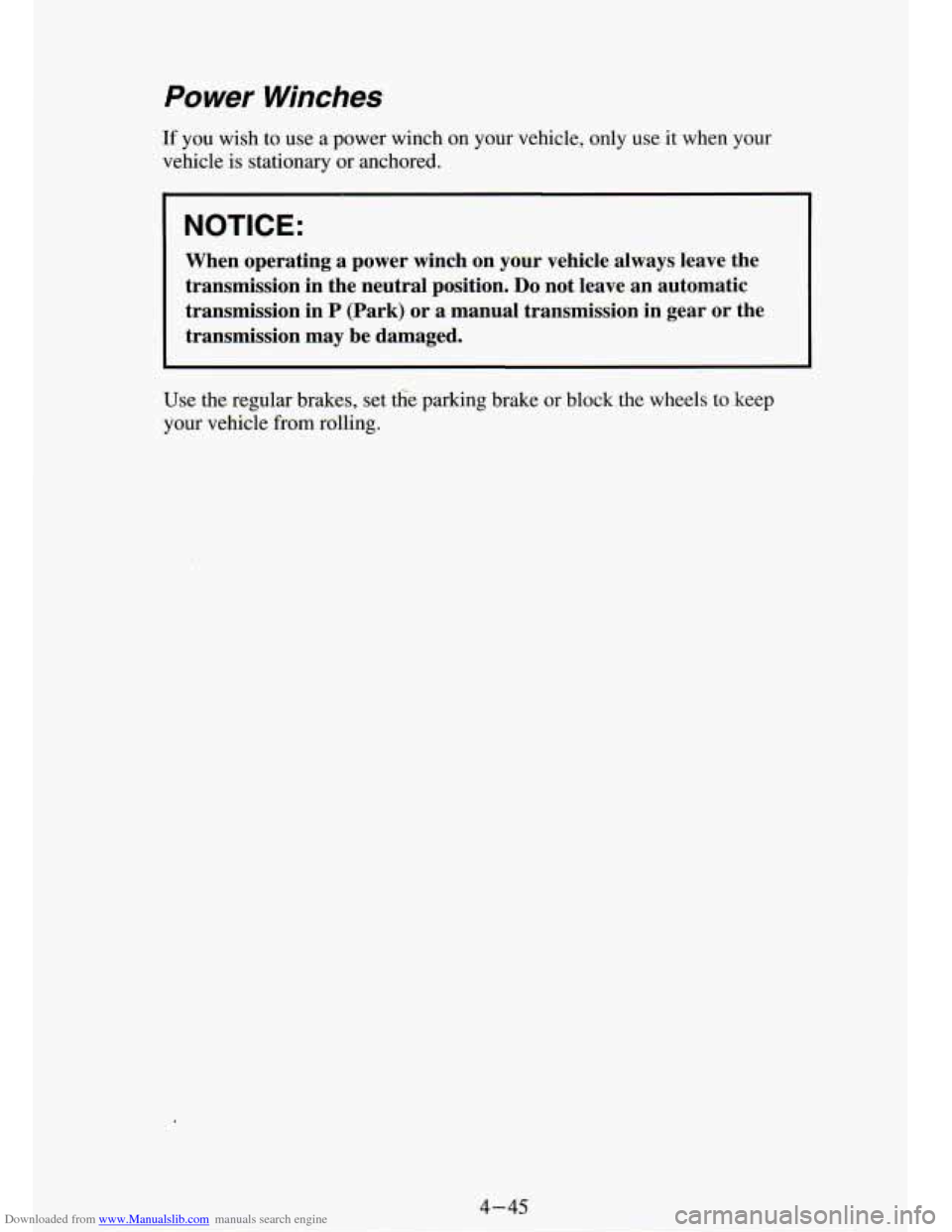
Downloaded from www.Manualslib.com manuals search engine Power Winches
If you wish to use a power wlncn on your vehicle, only use it when your
vehicle
is stationary or anchored.
NOTICE:
When operating a power winch on your vehicle always leave the \
transmission in the neutral position.
Do not leave an automatic
transmission in P (Park) or a manual transmission in gear or\
the
transmission may be damaged.
Use the regular brakes, set the parking brake or block the wh\
eels to keep
your vehicle from rolling.
4-45
Page 186 of 340
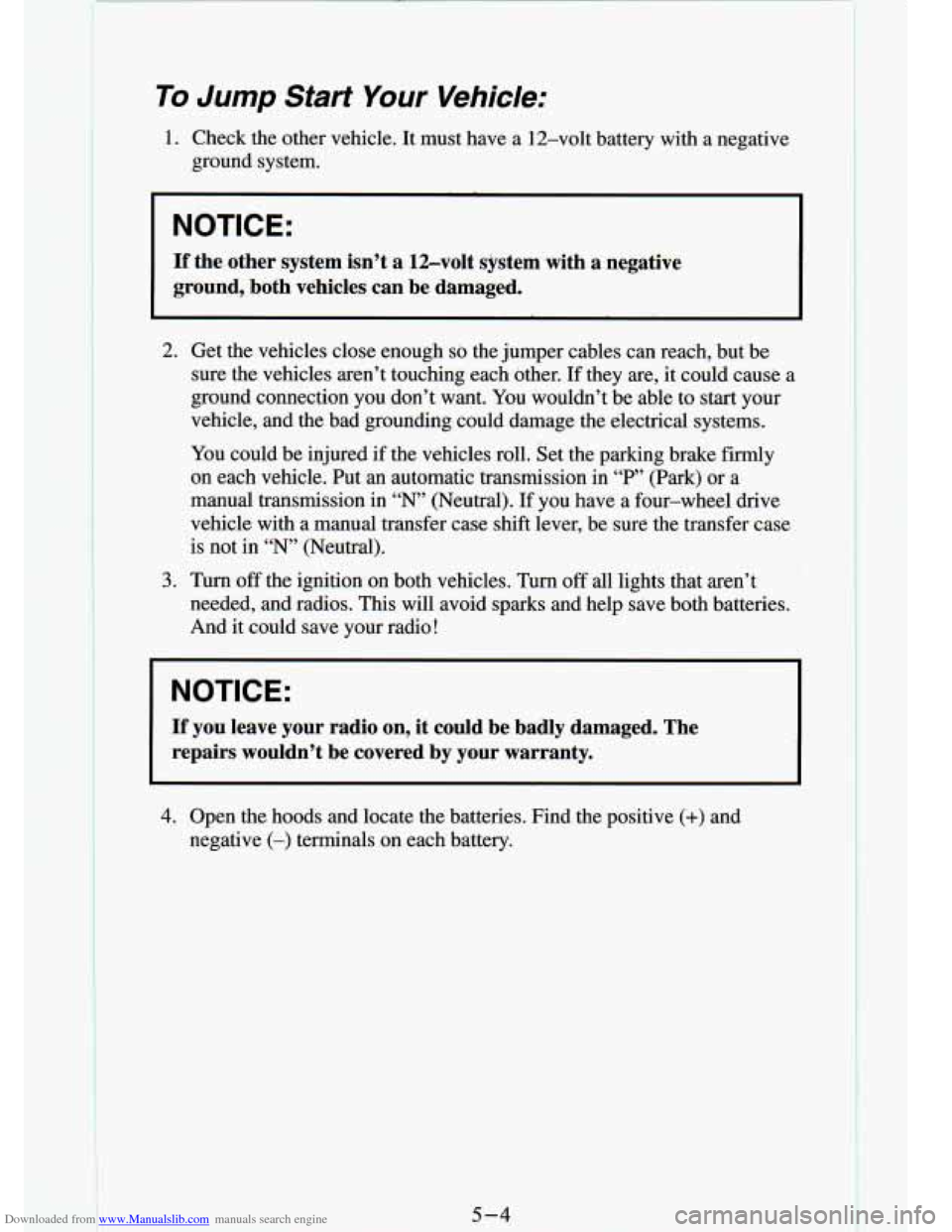
Downloaded from www.Manualslib.com manuals search engine I E
To Jump Start Your Vehicle:
1. Check the other vehicle. It must have a 12-volt battery wlm a\
negauve
ground system.
NOTICE:
If the other system isn’t a 12-volt system with a negative \
ground, both vehicles can be damaged.
2. Get the vehicles close enough so the jumper cables can reach, but be
sure the vehicles aren’t touching each other. If they are, it could cause
a
ground connection you don’t want. You wouldn’t be able to start your
vehicle, and the bad grounding could damage the electrical syst\
ems.
You could be injured if the vehicles roll, Set the parking brake
firmly
on each vehicle. Put an automatic transmission in “P” (Park)\
or a
manual transmission
in “N’ (Neutral). If you have a four-wheel drive
vehicle with
a manual transfer case shift lever, be sure the transfer case
is not in “N’ (Neutral).
3. Turn off the ignition on both vehicles. Turn off all lights t\
hat aren’t
needed, and radios. This will avoid sparks and help save both batteries.
And it could save your radio!
I NOTICE:
I
If you leave your radio on, it could be badly damaged. The
repairs wouldn’t be covered by your warranty.
4. Open the hoods and locate the batteries. Find the positive (+) and
negative
(-) terminals on each battery.
5-4
I
Page 234 of 340
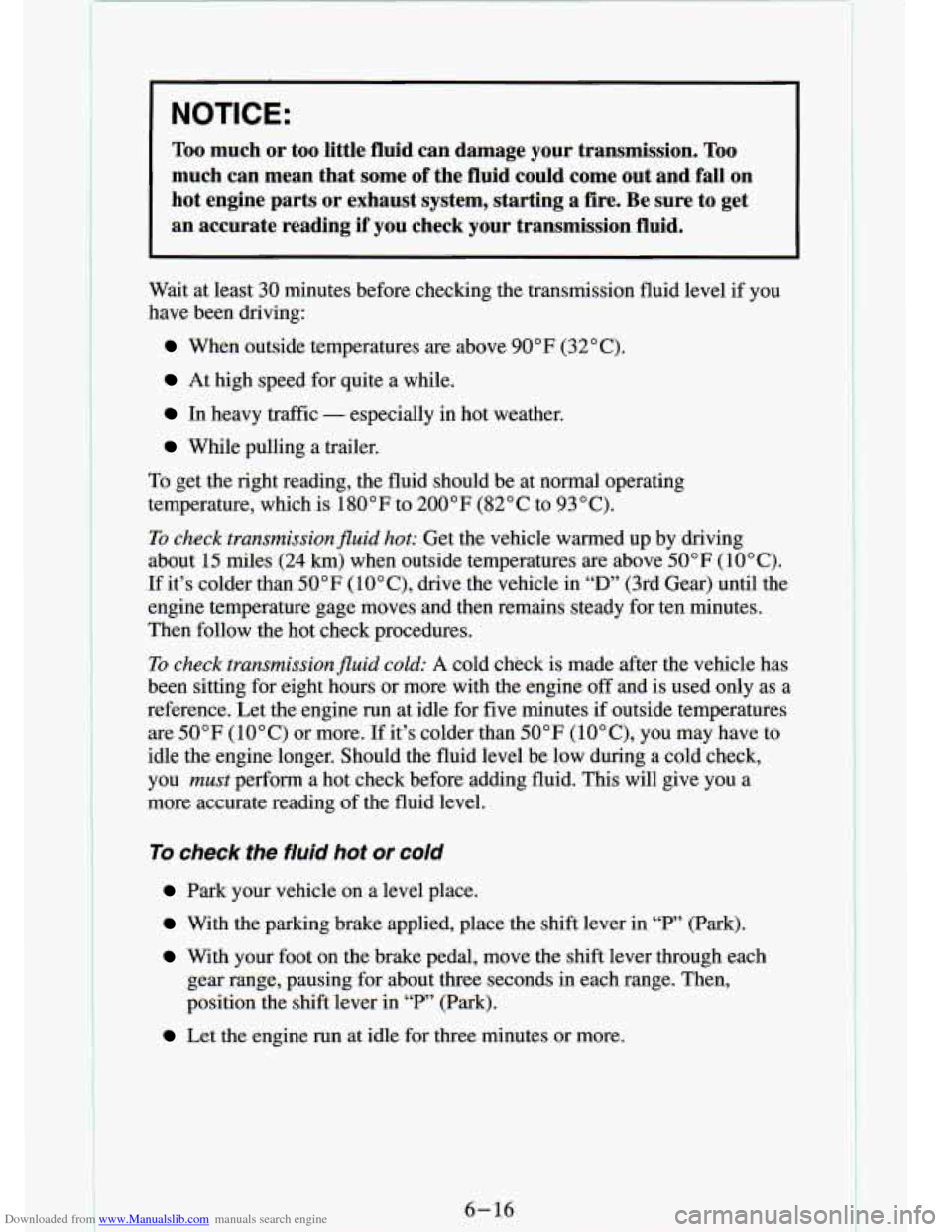
Downloaded from www.Manualslib.com manuals search engine . . . -*
I NOTICE:
Too much or too little fluid can damage your transmission. Too
much can mean that some of the fluid could come out and fall on
hot engine parts or exhaust system, starting a fire. Be sure to get
an accurate reading if you check your transmission fluid.
Wait at least 30 minutes before checking the transmission fluid\
level if you
have been driving:
When outside temperatures are above 90°F (32°C).
At high speed for quite a while.
In heavy traffic - especially in hot weather.
While pulling a trailer.
To get the right reading, the fluid should be at normal operating\
temperature, which is 180°F to 200°F (82°C to 93°C).
To check transmissionfluid hot: Get the vehicle warmed up by driving
about 15 miles (24
km) when outside temperatures are above 50°F (10OC).
If it's colder than 50°F (10" C), drive the vehicle in "D" (3rd Gear) until the
engine temperature gage moves and then remains steady for ten minutes.
Then follow the hot check procedures.
Tu check transmission fluid cold: A cold check is made after the vehicle has
been sitting for eight hours or more with the engine off and is used only as \
a
reference. Let the engine run at idle for five minutes if outside temperatures
are
50°F (10OC) or more. If it's colder than 50°F (lO"C), you may have to
idle the engine longer. Should the fluid level be low during a cold ch\
eck,
you
must perform a hot check before adding fluid. This will give you a\
more accurate reading of the fluid level.
To check the fluid hot or cold
Park your vehicle on a level place.
With the parking brake applied, place the shift lever in "P' (Park).
With your foot on the brake pedal, move the shift lever throu\
gh each
gear range, pausing
for about three seconds in each range. Then,
position the shift lever in
"P' (Park).
Let the engine run at idle for three minutes or more.
6- 16
I
Page 303 of 340
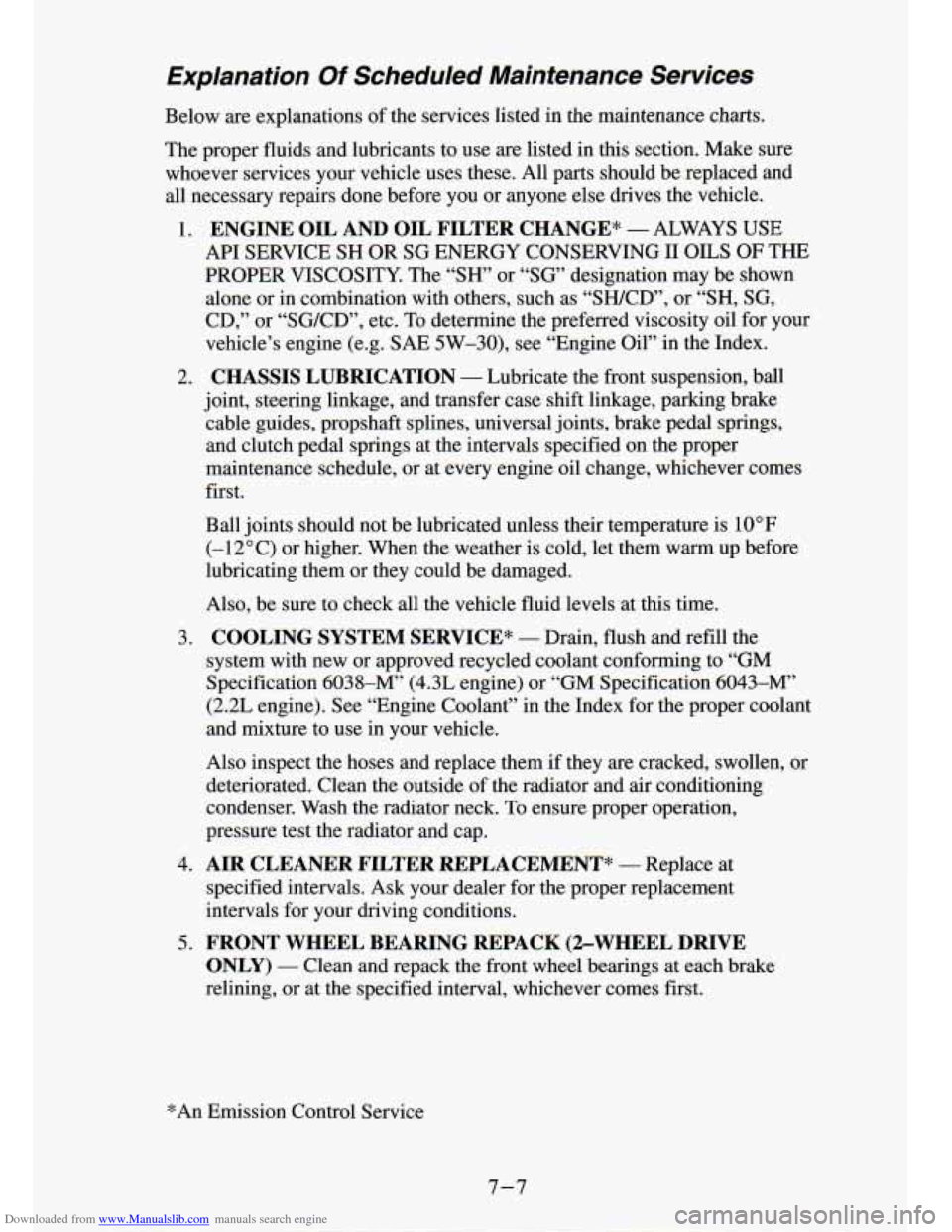
Downloaded from www.Manualslib.com manuals search engine Explanation Of Scheduled Maintenance Services
Below are explanations of the services listed in the maintenance charts.
The proper fluids and lubricants to use are listed
in this section. Make sure
whoever services your vehicle uses these. All parts should be \
replaced and
all necessary repairs done before you or anyone else drives the vehicle.
1. ENGINE OIL AND OIL FILTER CHANGE* - ALWAYS USE
API SERVICE SH OR SG ENERGY CONSERVING I1 OILS
OF THE
PROPER VISCOSITY. The “SH” or
“SG’ designation may be shown
alone or in combination with others, such as “SWCD”, or
“SH, SG,
CD,” or “SGKD”, etc. To determine the preferred viscosity oil for your
vehicle’s engine (e.g. SAE 5W-30), see “Engine
Oil” in the Index.
2. CHASSIS LUBRICATION - Lubricate the front suspension, ball
joint, steering linkage, and transfer case shift linkage, parking brake\
cable guides, propshaft splines, universal joints, brake pedal springs,
and clutch pedal springs at the intervals specified on the proper
maintenance schedule, or at every engine oil change, whichever comes
first
.
Ball joints should not be lubricated unless their temperature is 10°F
(-12°C) or higher. When the weather is cold, let them warm up before
lubricating them or they could be damaged.
Also, be sure
to check all the vehicle fluid levels at this time.
3.
COOLING SYSTEM SERVICE* - Drain, flush and refill the
system with new or approved recycled coolant conforming to “\
GM
Specification 6038-M” (4.3L engine) or “GM Specification 6043-M”
(2.2L engine). See “Engine Coolant” in the Index for the proper coolant
and mixture to use in your vehicle.
Also inspect the hoses and replace them if they are cracked, \
swollen, or
deteriorated. Clean the outside of the radiator and air conditioning
condenser. Wash the radiator neck. To ensure proper operation,
pressure test the radiator and cap.
4. AIR CLEANER FILTER REPLACEMENT* - Replace at
specified intervals. Ask your dealer for the proper replacement
intervals for your driving conditions.
5. FRONT WHEEL BEARING REPACK (%WHEEL DRIVE
ONLY) - Clean and repack the front wheel bearings at each brake
relining, or at the specified interval, whichever comes first.
*An Emission Control Service
7-7
Page 306 of 340
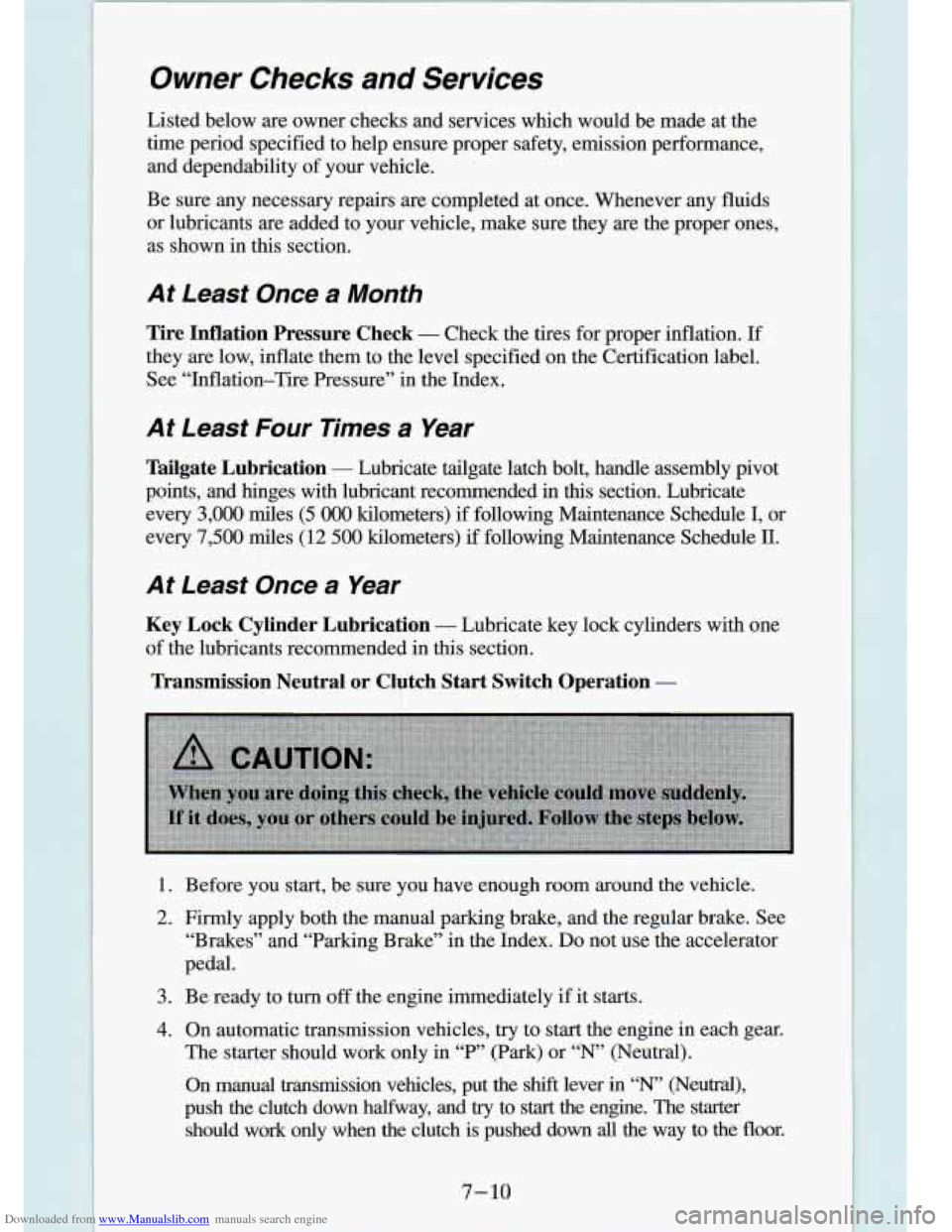
Downloaded from www.Manualslib.com manuals search engine Owner Checks and Services
Listed below are owner checks and services which would be made\
at the
time period specified to help ensure proper safety, emission pe\
rformance,
and dependability
of your vehicle.
Be sure any necessary repairs
are completed at once. Whenever any fluids
or lubricants are added to your vehicle, make sure they are t\
he proper ones,
as shown in this section.
At Least Once a Month
Tire Inflation Pressure Check - Check the tires for proper inflation. If
they
are low, inflate them to the level specified on the Certification \
label.
See “Inflation-Tire Pressure” in the Index.
At feast Four Times a Year
Tailgate Lubrication - Lubricate tailgate latch bolt, handle assembly pivot
points, and hinges with lubricant recommended in
this section. Lubricate
every
3,000 miles (5 000 kilometers) if following Maintenance Schedule I, or
every
7,500 &les (12 500 kilometers) if following Maintenance Schedule II.
At Least Once a Year
Key Lock Cylinder Lubrication - Lubricate key lock cylinders with one
of the lubricants recammended in
this section.
Transmission Neutral or Clutch Start Switch Operation -
1.
2.
3.
4.
Before you start, be sure you have enough room around the veh\
icle.
Firmly apply both the manual parking brake, and the regular br\
ake. See
“Brakes” and “Parking Brake” in the Index.
Do not use the accelerator
pedal.
Be ready to
turn off the engine immediately if it starts.
On automatic transmission vehicles,
try to start the engine in each gear.
The starter should work only in
T“ (Park) or “N’ (Neutral).
On manual transmission vehicles, put the shift lever in “N’ (Neutral),
push the clutch down halfway, and
try to start the engine. The starter
should work only when the clutch is pushed down
all the way to the floor.
7-10
Page 307 of 340

Downloaded from www.Manualslib.com manuals search engine Steering Column Lock Operation - While parked, try to turn the key to
LOCK in each gear shift position.
With an automatic transmission, the key should turn to LOCK only
0 With manual shift, the key should turn to LOCK only wnen you’re in
On vehicles with a key release lever, try to turn the key to
LOCK without
pressing the lever. The key should turn to
LOCK only with the key lever
depressed.
On
all vehicles, the key should come out only in LOCK.
when the gear shift is in “P’ (Park).
“R’ (Reverse).
Parking ‘Brake and Transmission “P’ (Park) Mechanism Operation -
Park on a fairly steep hill, with the vehicle facing downhill. Keeping your
foot on the regular brake, set the manual parking brake.
0
0 To check the parking brake: With the engine running and the
transmission
in “N” (Neutral), slowly remove foot pressure from the
regular brake pedal.
Do this until the vehicle is held by the parking
brake only.
To check the
“P’ (Park) mechanism’s holding ability: Apply the regular
brake and shift to
“P’ (Park). Release the manual parking brake, then
slowly release the regular brake.
Lap and Shoulder Belts Condition and Operation - Inspect belt system,
including: webbjng, buckles, latch plates, retractors, guide loops and
anchors. Have a belt assembly replaced
if the webbing has been cut or
otherwise damaged.
Body Lubrication Service - Lubricate all body door hinges including the
tailgate and tailgate handle pivot points. Lubricate the body hood, fuel door
and rear compartment hinges, latches and locks including interio\
r glove box
and console doors, and any moving seat hardware. Lubricate the \
hood safety
lever pivot and prop rod pivot.
More frequent lubrication may be required
when exposed to a corrosive environment.
7-11
Page 332 of 340
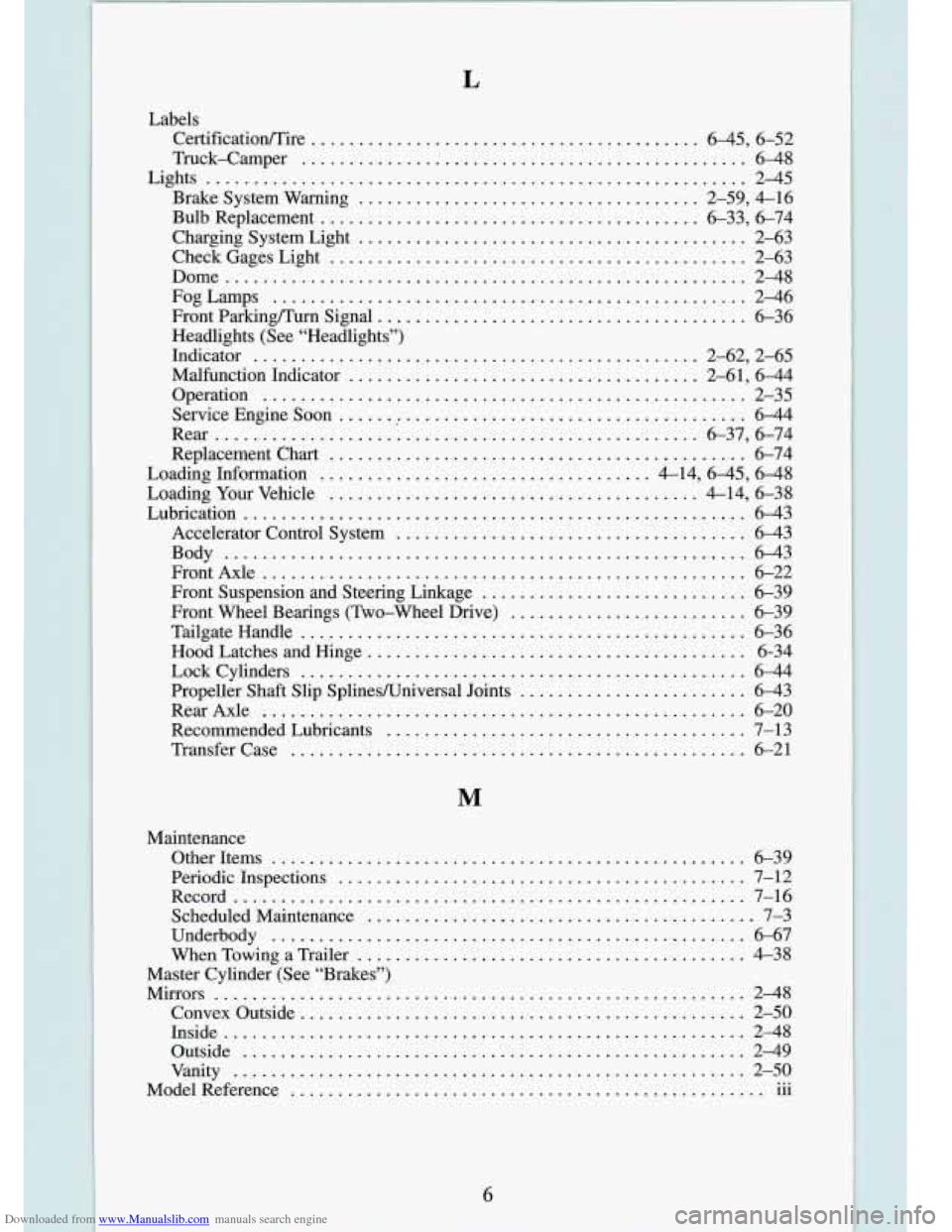
Downloaded from www.Manualslib.com manuals search engine L
Labels CertificatiodI‘ire
......................................... 6-45. 6.52
Truck-Camper
............................................... 6-48
Lights
......................................................... 2-45
Brake System Warning
.................................... 2.59. 4-16
Bulb Replacement
........................................ 6.33. 6-74
Charging System Light
......................................... 2-63
CheckGagesLight
............................................ 2-63
Dome
....................................................... 2-48
FogLamps
.................................................. 2-46
Front ParkingEurn Signal
....................................... 6-36
Headlights (See “Headlights”)
InQcator
............................................... 2.62. 2.65
Malfunction Indicator
..................................... 2.61. 6-44
Operation
................................................... 2-35
ServiceEngineSoon
........................................... 6-44
Rear
................................................... 6-37, 6-74
Replacement Chart
............................................ 6-74
Loading Information
................................... 4-14,645, 6-48
Loading Your Vehicle
....................................... 4-14, 6-38
Lubrication
..................................................... 6-43
Accelerator Control System
..................................... 6-43
Body
....................................................... 6-43
FrontAxle
................................................... 6-22
Front Suspension and Steering Linkage
............................ 6-39
Front Wheel Bearings (Two-Wheel Drive)
......................... 6-39
TailgateHandle
............................................... 6-36
HoodLatchesandHinge
........................................ 6-34
Lock Cylinders
............................................... 6-44
Propeller Shaft Slip SplinesNniversal Joints
........................ 6-43
RearAxle
................................................... 6-20
RecommendedLubricants
...................................... 7-13
Transfer Case
................................................ 6-21
M
Maintenance OtherItems
.................................................. 6-39
Record
...................................................... 7-16
ScheduledMaintenance
......................................... 7-3
Underbody
.................................................. 6-67
WhenTowingaTrailer
......................................... 4-38
Master Cylinder (See “Brakes”) Mirrors
........................................................ 2-48
Convexoutside
............................................... 2-50
Inside
....................................................... 2-48
Outside
..................................................... 2-49
Vanity
...................................................... 2-50
ModelReference
.................................................. 111
Periodic Inspections ........................................... 7-12
...
6